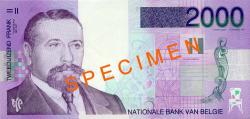1945-2002: the rise and the disappearance of the Belgian franc
The decision to replace the old pre-war coins with cupronickel and silver coins – the last ones to be issued in Belgium – was taken in 1948. Except in the case of the 100 F coin, there was no reference at all to the royal family on these coins: Belgium was ruled by the Regent, and there was opposition to King Leopold III.
In 1944, Belgium joined the new international monetary system, for which the rules were laid down at the Bretton Woods conference, setting up the International Monetary Fund. The Belgian franc was based on a gold exchange standard, incorporating a global system of fixed exchange rates via its parities with gold and the US dollar. Up to the end of the 1960s, when the abundance of dollars in the world generated severe tension on the foreign exchange markets, the Bretton Woods system led to relatively stable exchange rates. In August 1971 the United States suspended the convertibility of the dollar into gold. The next year, Europeans devised a system of monitoring and regulating exchange rates, the European Monetary Snake, which was to be developed into the European Monetary System in 1979.
In Belgium, as in much of the industrialised world, the 1960s were years of very rapid economic and social progress. Between 1961 and 1973, the purchasing power of wages doubled. In 1960, there was one car for every 13 inhabitants. That figure increased to one for 6.7 in 1966, then to one for 4.8 in 1973. There was substantial investment by the state, which shouldered the growing burden of social security. The country created one of the densest road networks in the world. But in common with the majority of the industrial economies, Belgium was also hard hit by the 1973 oil crisis. This ushered in a period of uncertainty, notable for the dramatic rise in unemployment and Belgium’s ballooning public debt. However, following the 1982 devaluation, accompanied by a reform policy, the Belgian franc gradually became one of the strongest currencies in the European Union; this was confirmed by the 1990 decision to peg the Belgian franc to the German mark. The next year, the Maastricht summit laid down the conditions for joining Monetary Union. Belgium made it a point of honour to satisfy those conditions.

The banknotes issued by the National Bank abandoned the allegorical style of the early 1960s to pay tribute to prominent figures from the "national" past: the final 40 years of the Belgian franc are thus represented by an illustrious portrait gallery. Many people still remember the last series of national banknotes, issued from 1994. It pays tribute to such famous 19th and 20th century artists as Sax, who invented the saxophone, the architect Victor Horta and the painter René Magritte.
The coins designed during the Regency were retained for an exceptionally long period, not being replaced until the late 1980s. The Royal Mint also struck commemorative coins, and coins denominated in ecu, which was initially expected to be the name of the single currency. But although they were sometimes legal tender, these coins never went into ordinary circulation. We had to wait until the 3rd millennium before the European currency, renamed the euro, appeared in our wallets. But that’s another story...
